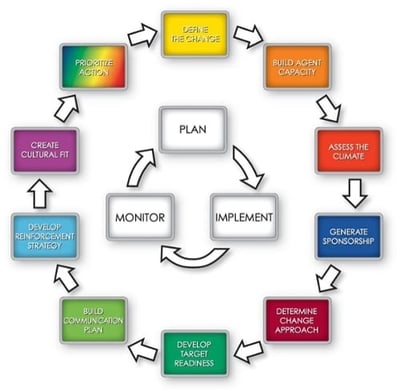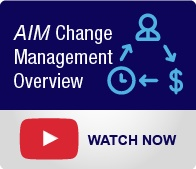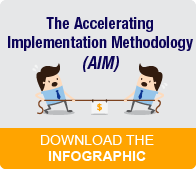One of the challenges for Change Agents and organizations is to sort through all the various "change management methodologies" and identify what fits best for your needs. We have talked about a comparison of the Accelerating Implementation Methodology (AIM) to the ADKAR model from Prosci. How does AIM compare to the 8 step Kotter model? 
Just in terms of language, we don't even like the change management label for AIM, because the framework is really focused on "implementation management." This is important, because even though the concepts of Kotter's model and AIM are aligned, AIM provides the "how." It is an operational approach to implementing strategic changes in organizations.
There is no disagreement with the basic tenets of Kotter, and many executives think of Kotter when they think of "change management." There is also no doubt that Kotter has additional credibility because of the Harvard connection.
This is all good, but the organizational reality is that we have to have a way to actually apply these principles and concepts to the every day work of organizations! So the "how" is a significant benefit. AIM provides a quicker Return on Investment for changes.
The "how" is not just because AIM has tools. It's because the methodology is deliverables-based, practical, tactical and strategic, and designed to be fully integrated into the technical project management plan.
Let's look at some examples of how Kotter and AIM align:
Kotter Step One: Establish a Sense of Urgency and Kotter Step 3: Develop the Change Vision and Strategy, map to Define the Change in AIM
Yes, there must be a motivation to change, but many changes aren't necessarily a result of a burning platform. In fact, Don Harrison, the developer of AIM, notes that if you have to have a burning platform the organization will need "greater conflagrations over time" to move.
The sense of urgency and the Change Vision and Strategy (Kotter Step 3) can't just be a communication top-down that is the corporate "sense of urgency" or the corporate vision. The need to change has to be translated into the varying Frames of Reference from all the Targets of the change. 
In AIM, we use the Project Overview Tool as the foundation for describing the change in behavioral terms. What is it that we want people to do differently as a result of this change? These behavioral objectives are identified not just once, but ultimately for each group that is impacted.
How do you then actually communicate the Change Vision? In AIM we use the Business Case for Action as the deliverable for the communication. It's an elevator speech format for making the case for the change in very simple terms that can be described consistently by leaders:
- What is changing?
- Why are we making this change?
- What happens if we don't make this change successfully?
- How will this change impact you?
Concepts are translated into actions.
Kotter Step 2: Pull Together the Guiding Team maps to Build Agent Capacity and Generate Sponsorship in AIM
Yes, we clearly need to have a guiding team of both Sponsors and Agents. These individuals have specific roles and responsibilities in the implementation process. How do you exactly accomplish the assignment of roles?
First, in AIM we use key role mapping to identify, starting at the lowest level of impact and working our way up, who are the Targets of the change, level by level. Once we know that, we can identify specific individuals we need to engage as Reinforcing Sponsors. Then we can see how many Change Agents we will need, and where they will need to be located.
But who are these Change Agents? We use the Change Agent Assessment tool to identify the individuals with the right skills, traits and characteristics for the localized work areas impacted by the change.
This moves beyond a high level Stakeholder Assessment and operationalizes putting a change structure (or "guiding team" in Kotter's terms) in place.
These are just two examples. What's a better fit for your organization? How will you operationalize core principles into actions that are repeatable for every project, no matter what the size or complexity?


